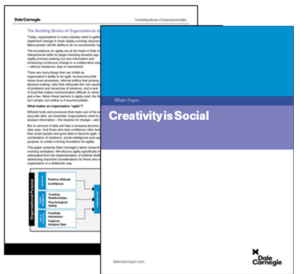
As a Director and Senior Consultant at Dale Carnegie Training, Nathan McNee directs culture, leadership, and commercial excellence programmes for global-level clients. In the first of this series, Nathan discusses his take on the key elements inherent in ‘people first’ cultures.
Creativity and People First Culture
Dale Carnegie’s global research specialists, AKA our Thought Leadership Team in New York, have uncovered a range of interesting facts on the power of creativity in business culture. One study, involving five thousand employees across 15 countries, indicated that in the most innovative companies, everyone has a role in developing an idea and bringing it to market. Unfortunately, creativity can often give way to the constraints of process, perfection, doubt, and perceived best practices. This is where a clearly defined innovation process can come into play.
Earlier in my career, I collaborated with a talented team of technical site managers, responsible for welfare, policy infrastructure and implementation. Over time, their influence had eroded at senior level, making policy implementation more challenging. To be impactful and have their voice heard, they understood the need to think and act creatively. The key was providing a framework to voice ideas and suggestions.
We took them through an eight-step Dale Carnegie innovation process, designed to turn vision into reality and create a platform to feed their ideas and processes back into the business in a meaningful way.
This defined process for innovation, enabled them to assess their current situation, look for opportunities to improve, and present those ideas back to the business confidently, engaging key stakeholders, using data and a robust thinking mechanism designed to create idea fluency. Once clear on the recommendations, their outputs resulted in practical changes that made a real difference to the business and created for the team a platform to communicate and collaborate effectively.
Why creativity matters for your people first culture

Our researchers found that creative organisations excelled in wellbeing, psychological safety, diversity, and purpose. Creativity requires trust and workers empowered to contribute to an organisation’s creative output are, our team found ‘more likely to produce novel and useful ideas to be turned into innovations.’ They determined,
In highly creative companies, 64% of employees strongly agreed their managers make them feel valued, 71% said they strongly agree that they feel confident in their skills, and 59% strongly agreed that they are empowered to make decisions at work. In companies deemed less creative, those percentages were much lower: 17%, 29%, and 15% respectively.
Intrinsic motivation
By way of definition, intrinsic motivation comes from within, the values and actions borne out of our innate desire (think a sculptor’s inclination to sculpt). External factors drive extrinsic motivation – think sales commission, bonuses, the need to pay bills, etc. This matters, as our team discovered that ‘a strong sense of intrinsic motivation is needed for employees to want and be able to be creative’.
How leaders can boost intrinsic motivation
To use intrinsic motivation, leaders can start by connecting each employee’s ‘why’ to company mission, show acknowledgement and appreciation, empowering employees to make decisions and implement their ideas, and ongoing development to drive skills and confidence.
More than just a buzzword
In the year of ‘The Great Resignation’ and in the battle for attracting the best talent, businesses of all sizes need to understand that ‘People First Cultures’ need to be much more than just a line in company mission statement. It needs to be underpinned by the behaviours of leaders from the top down ensuring it is embedded in your company values, making you a company people want to work for and a business customers want to work with.
Resources
How to Drive a Culture of Creativity for 10 key drivers of organisational creativity
and a complimentary whitepaper detailing our research into creativity.



